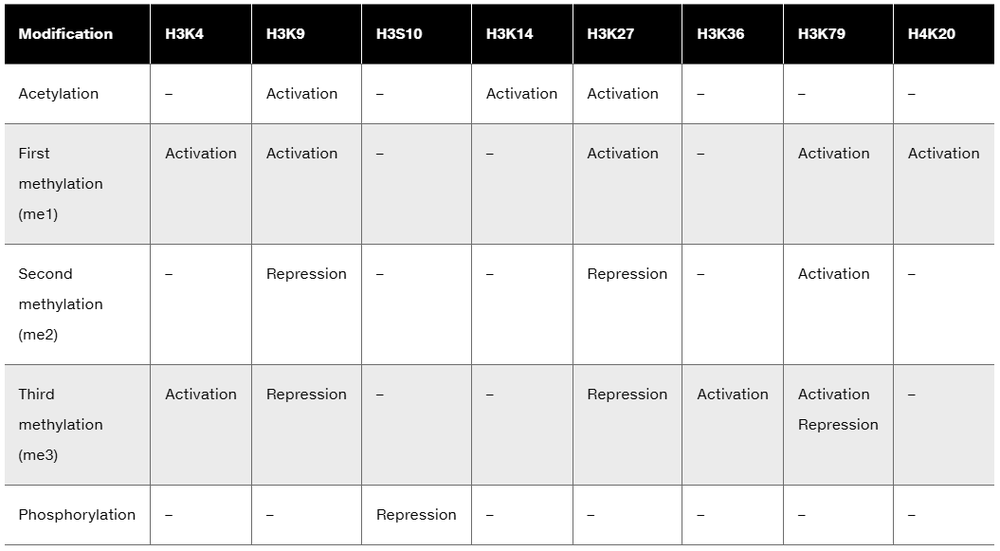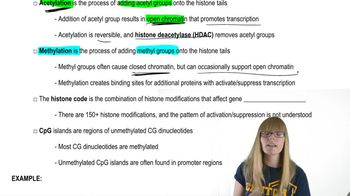Trace the relationship between the methylation status of the glucocorticoid receptor gene and the behavioral response to stress.
Table of contents
- 1. Introduction to Genetics51m
- 2. Mendel's Laws of Inheritance3h 37m
- 3. Extensions to Mendelian Inheritance2h 41m
- 4. Genetic Mapping and Linkage2h 28m
- 5. Genetics of Bacteria and Viruses1h 21m
- 6. Chromosomal Variation1h 48m
- 7. DNA and Chromosome Structure56m
- 8. DNA Replication1h 10m
- 9. Mitosis and Meiosis1h 34m
- 10. Transcription1h 0m
- 11. Translation58m
- 12. Gene Regulation in Prokaryotes1h 19m
- 13. Gene Regulation in Eukaryotes44m
- 14. Genetic Control of Development44m
- 15. Genomes and Genomics1h 50m
- 16. Transposable Elements47m
- 17. Mutation, Repair, and Recombination1h 6m
- 18. Molecular Genetic Tools19m
- 19. Cancer Genetics29m
- 20. Quantitative Genetics1h 26m
- 21. Population Genetics50m
- 22. Evolutionary Genetics29m
13. Gene Regulation in Eukaryotes
Epigenetics, Chromatin Modifications, and Regulation
Problem 22c
Textbook Question
From the following table, draw up a list of histone H3 modifications associated with gene activation. Then draw up a list of H3 modifications associated with repression.
If not, how can you reconcile these differences?

 Verified step by step guidance
Verified step by step guidance1
Step 1: Understand that histone H3 modifications are chemical changes to the histone protein that affect chromatin structure and gene expression. These modifications can either activate or repress gene transcription depending on their type and location.
Step 2: List common histone H3 modifications associated with gene activation. These typically include methylation at lysine 4 (H3K4me), acetylation at lysine 9 (H3K9ac), and acetylation at lysine 27 (H3K27ac). These modifications generally open chromatin structure, making DNA more accessible for transcription.
Step 3: List common histone H3 modifications associated with gene repression. These often include methylation at lysine 9 (H3K9me) and lysine 27 (H3K27me). These marks promote chromatin compaction, reducing access of transcription machinery to DNA.
Step 4: Recognize that some modifications can have context-dependent effects, and the same modification might be associated with activation in one context and repression in another. This is due to the complex interplay of multiple histone marks, the presence of specific binding proteins, and the overall chromatin environment.
Step 5: To reconcile differences, consider the 'histone code' hypothesis, which suggests that combinations of histone modifications, rather than single marks alone, determine the functional outcome on gene expression. Also, cross-talk between modifications and recruitment of different effector proteins can explain why some modifications have variable effects.
 Verified video answer for a similar problem:
Verified video answer for a similar problem:This video solution was recommended by our tutors as helpful for the problem above
Video duration:
1mPlay a video:
Was this helpful?
Key Concepts
Here are the essential concepts you must grasp in order to answer the question correctly.
Histone Modifications and Their Role in Gene Regulation
Histone modifications are chemical changes to histone proteins, such as methylation or acetylation, that influence chromatin structure and gene expression. These modifications can either promote gene activation by loosening chromatin or cause repression by tightening it, thereby controlling access to DNA.
Recommended video:
Guided course

Histone Protein Modifications
Specific Histone H3 Modifications Linked to Activation and Repression
Certain modifications on histone H3 correlate with gene activity states: for example, H3K4me3 and H3K27ac are commonly associated with active transcription, while H3K9me3 and H3K27me3 are linked to gene silencing. Recognizing these marks helps distinguish active from repressed chromatin regions.
Recommended video:
Guided course

Histone Protein Modifications
Context-Dependent Nature of Histone Modifications
Histone modifications do not act in isolation; their effects depend on the combination of marks, chromatin context, and interacting proteins. This complexity can explain apparent contradictions, as the same modification might have different outcomes depending on cellular conditions or genomic location.
Recommended video:
Guided course

Histone Protein Modifications
Related Videos
Related Practice
Textbook Question
590
views


